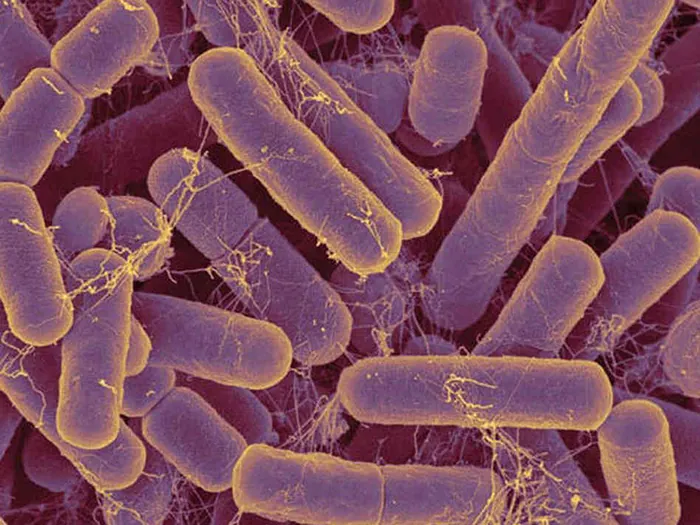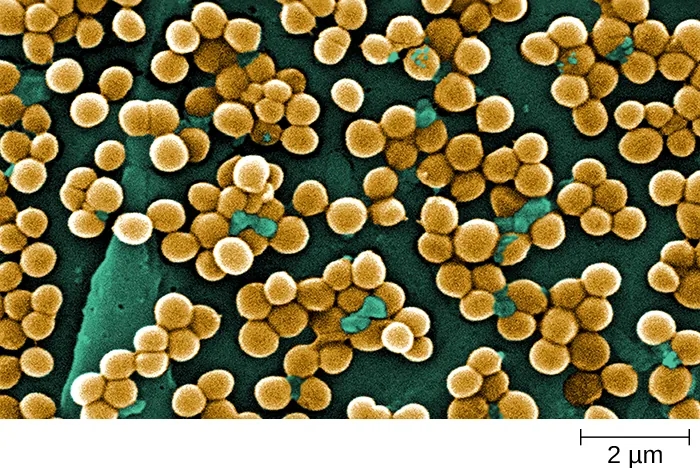Microbiology Chapter 4; Prokaryotes
1/49
There's no tags or description
Looks like no tags are added yet.
Name | Mastery | Learn | Test | Matching | Spaced |
|---|
No study sessions yet.
50 Terms
What is mutualism?
Two species benefit from one another.
Humans and healthy GI bacteria.
Bacteria break down molecules for human digestion and their own metabolism.
What is amensalsim?
When one population harms another but remains unaffected itself.
Some bacteria on the skin.
What is commensalism?
One population benefits while the other is unaffected.
Bacteria on the skin using dead skin cells.
What is neutralism?
When neither species is affected by the relationship.
Endospores in an unchanging environment.
What is parasitism?
When one species harms another for its benefit.
Pathogenic bacteria.
What are resident microbiota?
Organisms that live constantly in or on human bodies.
Permanently found bacteria.
What is transient microbiota>
Microorganisms that temporarily reside in or on the body.
Can include pathogenic bacteria.
What can alter the amounts of resident and transient microbiota in or on humans?
Hygiene and diet.
What percentage of bacteria are pathogenic?
Only 1%.
The other 99% are helpful to the environment;
regulate immunity
capture and recycle elements
Microbiota vs Microbiome?
Microbiota refers to the population of microorganisms in a specific environment.
Microbiome refers to both the microorganisms and their collective genetic material within an environment.
Different microbiota are found in different microbiome sites.
Where do humans acquire a majority of their microbiota?
During vaginal birth;
There is a build up of necessary bacteria in the vaginal canal.
The baby ingests these during birth.
What type of birth provides greater protection for babies in terms of microbiota?
Natural births, because C-sections inhibit the ability for the baby to ingest natural flora.
Additional microbes can be acquired from doctors and surface interactions with other individuals.
How do we classify prokaryotes (4 ways)?
Shape
Staining patterns
Biochemical differences
Nucleotide sequencing
How do we classify bacteria by staining?
Gram staining;
+ive — purple
-ive — pink
Atypical — no stain
Mycoplasma and Chlamydia
What are the 2 phylums of gram negative bacteria?
Proteobacteria
Nonproteobacteria
How are gram positive bacteria classified based on DNA sequence?
Low G+C content.
Less than 50% of G and C in DNA.
High G+C content.
More than 50% of G and C in DNA.
What are the 5 classes of Proteobacteria?
Alphaproteobacteria
Betaproteobacteria
Gammaproteobacteria
Deltaproteobacteria
Epsilonproteobacteria
What are Facultative intracellular pathogens?
They are capable of living reproducing in and out of host cells.
Facultative anaerobes;
Thrive in oxygenated conditions.
Can also use anaerobic metabolism if no O2 is present.
What are Obligate Intracellular Pathogens?
They are only capable of living and reproducing inside a host.
Obligate Anaerobes;
Thrive when there is low oxygen within the host.
Obligate Aerobes;
Thrive when there is O2 available within the host.
Are Proteobacteria gram negative or positive?
Gram negative.
Characteristics of Alphaproteobacteria? Example?
A class in phylum Proteobacteria.
Gram negative.
Facultative or Obligate.
Mainly Obligate - reproduce in host.
Mostly bacillus.
Rickettsias; obligate, transmitted by ticks.
Characteristics of Betaproteobacteria? Example?
A class in phylum Proteobacteria.
Gram negative.
Most require aqueous environments.
Aerobic, but diverse metabolic pathways.
Bordetella pertussis.;
Whooping cough.
Neisseria spp.;
DEADLY — Meningitis and gonorrhea.
Diplococci
Characterisitcs of Gammproteobacteria? Exmaple?
A class in phylum Proteobacteria.
**Largest and most diverse!
Gram negative.
Mostly bacillus with flagella.
Mainly aerobic, mainly facultative.
Some are enteric (reside in human GI).
Cause diarrhea, vomiting, abdominal pain.
Pseudomona spp.;
Aerobic and non-fermenting.
Highly motile.
Highly resistant - high concentration in hospitals.
Difficult to treat.
Deadly.
What stain are most GI bacteria?
Gram negative with flagella.
What are enteric bacteria?
Bacteria that reside in the GI tract.
Gram -ive.
Pathogenic enteric bacteria cause diarrhea, vomiting, abdominal pain.
Facultative anaerobes.
What are microaerophiles?
Microorganisms that require low levels of O2.
Neisseria
What are some unique examples of Gammaproteobacteria?
Shigella;
Nonmotile; probably lack flagella.
Escherichia;
Facultative ANaerobe.
Deadly Shiga toxin
Characteristics of Deltaproteobacteria? Example?
A class in phylum proteobacteria.
Use sulfate as final electron acceptor, rather than oxygen.
Thrive in unique environments.
Not pathogenic to humans.
Gram negative.
Characteristics of Epsilonproteobacteria? Example?
A class in phylum proteobacteria.
**Smallest class!
Microaerophilic; need low amounts of O2.
Found in the GI.
Transmit through water; fecal-oral.
Spiral shaped.
Campylobacter;
Cause severe enteritis via uncooked meat.
Kills our nervous system.
Helicobacter; H. pilari;
Cause gastritis, gastric cancer.
Damage stomach lining.
What are the 4 types on nonproteobacteria?
Chlamydia.
Spirochetes.
Cytophaga-Fusobacterium-Bacteroides (CFB) - our microbiome.
Planctomycetes
Are nonproteobacteria gram -ive or +ive?
Gram negative.
Characteristics of Chlamydia?
A class of phylum Nonproteobacteria.
They are;
Obligate.
Atypical staining.
Extremely resistant.
Degenerative until inside host (endospore-like).
Cocci or coccobacilli
Characteristics of Spirochetes?
A class of phylum Nonproteobacteria.
Long and spiral shaped.
Impossible to culture because extremely thin.
Use darkfield and fluorescent microscopy.
Treponema pallidum; syphilis.
Borrelia; lyme disease
Characteristics of CFB?
A class of phylum Nonproteobacteria.
Obligate anaerobes.
NONPATHOGENIC.
Prevalent in human intestines.
Bacillus
Bacteroides;
30% of GI microbiome.

What class of bacteria is this?
Bacteroides, belonging to CFB.
In phylum Nonproteobacteria.
Non-pathogenic.
What are phototropic bactera?
They use sunlight as their primary energy source.
ATP synthesized by solar energy.
Both proteo or nonproteo.
They can produce oxygen = oxygenic photosynthesis.
Cyanobacteria; use chlorophyll.
They don’t produce oxygen = anoxygenic photosynthesis.
What are High GC gram positive bacteria? Characterisitcs?
Class Actinobacteria.
Mainly aerobic.
Many different peptidoglycans in cell wall.
Examples of Actinobacteria?
Gram positive and aerobic.
Mycobacterium — have mycolic acid — acid fast.
Tuberculosis.
Cornyebacterium
Gardnerella
Nocardia
Streptomyces
What are the 4 main classes of low GC gram positive bacteria?
Clostridia - endospore forming.
Lactobacillales - includes streptococcus
Bacili - include both rod and cocci shapes.
Includes staphylococcus aureus - responsible for food poisoning.
Includes B. anthracis - responsible for anthrax.
Mycoplasma spp. - pleomorphic (variety of shapes due to lack of cell wall).
Characterisitcs of Clostridia?
A gram positive, low GC bacteria.
Seen as “C. species.
Are endospore forming.
Characteristics of the Streptococcus genus?
A genus in class Lactobacillales.
Gram positive Low GC.
Often introduced as strep throat, but can lead to rheumatic fever, pharyngitis, pneumonia, and other respiratory infections.
Can be deadly if untreated.
Produces toxins/
Characteristics of Staphylococcus aureus?
A genus species in the class Bacili.
Gram positive Low GC.
Are neutralisitc in normal environments, and often reside on our skin.

What genus species is this?
Staphylococcus aureus; a low GC gram positive Bacili.
Why aren’t Archaea pathogenic?
They are extremophiles; they live in extreme environments not suitable for the human body.
What differentiates archaea from bacteria?
While they are both unicellular and prokaryotic, archaea have different;
genetics
biochemistry
ecology.
What type of prokaryotes produce methane?
Only archaea are methanogens.
What do Hemophilus spp. cause?
They can cause upper respiratory tract infections.
A genus in class Gammaproteobacteria, gram negative.
What do spirochetes use to propel themselves?
Spirochetes are motile but don’t possess flagella.
They use the axial filament.
How can we try to eliminate transient bacteria?
With antibiotics.
What genus can cause malaria?
Plasmodium